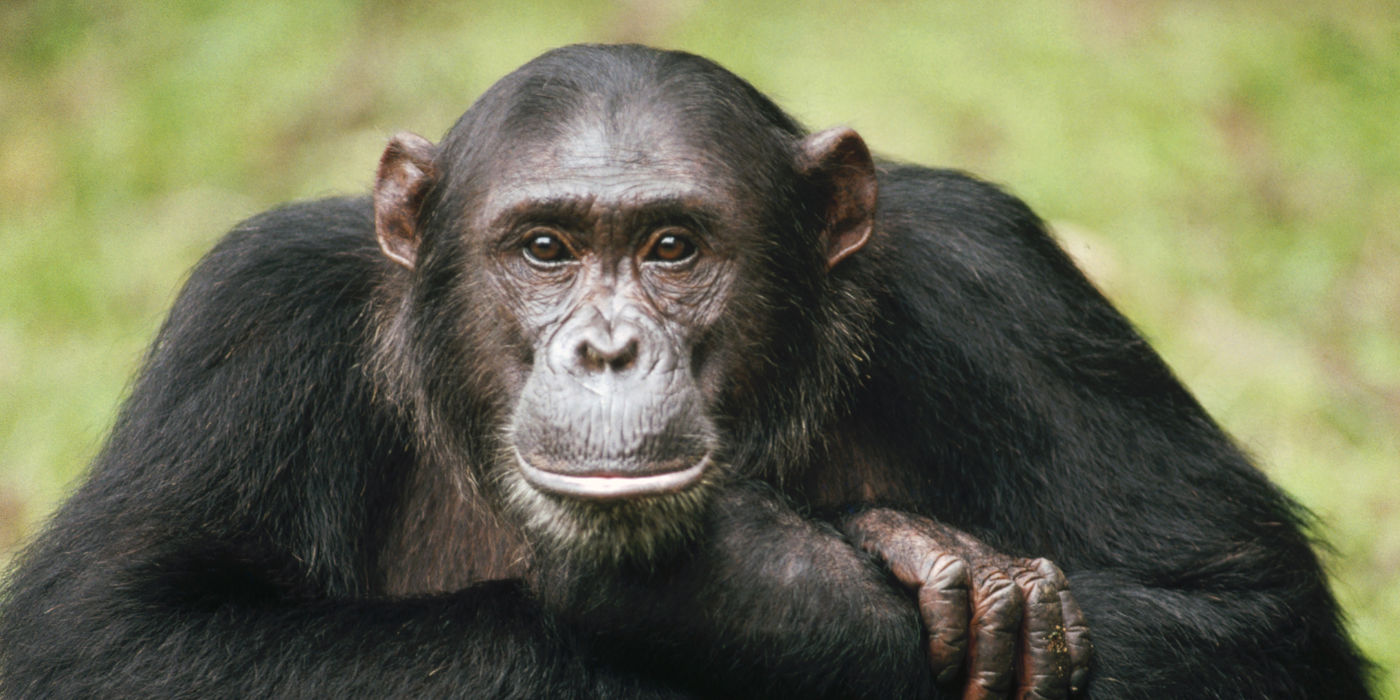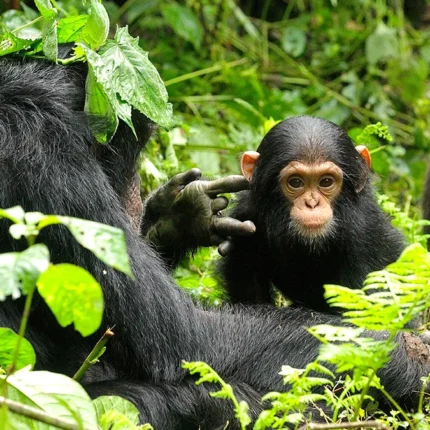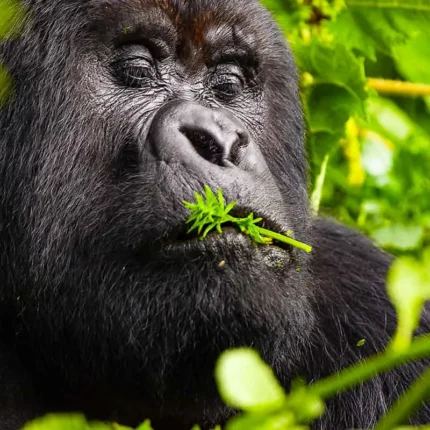Your ultimate African primate safari awaits! We’re going to visit key primate-specific National Parks with a variety of different primate species. With this tour, you’ll never be bored and you’ll always be learning about the different types of primates in Uganda from the famous Mountain Gorillas, the Endemic Uganda mangabey and the chimpanzees
THE 11 DAY ULTIMATE AFRICAN PRIMATE SAFARI
Depart Kampala for Bwindi Impenetrable Forest.
Mountain gorillas only live in the dense vegetation of Uganda’s Bwindi Impenetrable National Park and along the dormant volcanic Virunga Mountain range that stretches across Rwanda’s Volcanoes National Park, Uganda’s Mgahinga Gorilla National Park, and Virunga National Park in the Democratic Republic of the Congo.
Bwindi Impenetrable forest is home to roughly half of the world’s endangered mountain gorillas, about 330 individuals, and one of the safest places to track these magnificent giants. The park has 90 mammal species, including 11 primates, of which the black-and-white colobus, with its lovely flowing white tail, is prominent. The forest birding ranks extremely high with 23 highly localized Albertine Rift endemics and in 2012 Bwindi was declared a favourite birding habitat in Africa by ornithologists. Proceed to your lodge, check in and enjoy the life and sound of the tropical rainforest.
Dinner and overnight at Silverback Safari Lodge
Today on the African primate safari you have the opportunity to track the critically endangered mountain gorilla. Tracking these fascinating creatures through the misty Ugandan forests requires patience and stamina, not to mention adventurous and hopeful hours spent walking in the mud and the wet rainforest floor. But the payoff is indescribable: there is no way to express the thrill of coming upon a family of gorillas going about their daily activities in the undergrowth.
Sitting in silence on the cold ground of a Ugandan forest for 60 minutes might be one of life’s greatest privileges. There are fewer than 900 mountain gorillas in existence, and gorilla trekking provides a rare opportunity to observe the everyday interactions of these gentle, mysterious primates. Witnessing their way of life and how alike they are to humans is overwhelming. The opportunity to trek within meters of one of the world’s last few hundred mountain gorillas is arguably the most exciting wildlife encounter in Africa. You will have a picnic lunch in the forest.
Return to the lodge and recuperate after the excitement of the day.
After a leisurely breakfast, the African primate safari offers a village walk to meet and learn more about the local community living around the park and witness how gorilla tourism in this area boosted by gorilla tracking is benefiting them. Habitat destruction is the main threat to mountain gorillas. Communities around the parks are heavily populated, and residents have traditionally used the land around national park boundaries for farming or logging.
Since tourism is now Uganda’s most lucrative industry, and the majority of tourists come to see the mountain gorillas, trekkers are encouraged to seek out ways to give back to the communities they visit.
The 4-hour walk will introduce you to the customs and practices of the Batwa and Bakiga people. Some of the places you will visit include a local handicraft shop that is run by women in the community. The women design and produce a wide variety of beautiful traditional crafts such as mats, wood carvings, dyed clothes, weavings and so much more. They get to earn a little more revenue from the sales of their work to meet their living costs and cater to their families. The walk then leads you through the kempt tea plantations which thrive on the rich fertile volcanic soils of the Albertine rift valley. You will learn more about the cultivation, processing, and distribution of tea in this part of the country. The walk then leads you through the small food gardens and open fields where boys herd the beautiful long-horned Ankole cattle. The next stop will be at a traditional medicinal healer. About 70% of people living in rural areas still depend on traditional remedies to treat their ailments or may use them concurrently with modern medicine. The healer not only provides medicines to those who are sick but also contributes to the survival of the various shrubs, herbs, and plants by educating the local people about the benefits of such species. He is known to have a cure for anything from stomach aches to male impotence (a form of traditional Viagra!). Other stops and activities include the local primary school, a banana brewing process and finally, conclude with dancing performances with Batwa (pygmy) community. Return to the lodge for dinner and overnight.
After a leisurely breakfast, you will be transferred to Queen Elizabeth National Park. The drive will take you through the southern sector of the park and you will have a game drive at Ishasha. The Ishasha plains rank with the most appealing game-viewing areas in the country, as much for its unspoiled mood as its varied wildlife. The area is famous for its lions, one of the few populations in Africa that customarily climb trees. To see a pride of up to 14 lions or more up a tree, all fast asleep with huge distended bellies will leave you with fond memories of Africa. Proceed to the lodge and check in.
Laze by the pool while enjoying the vastness of the savanna.
Dinner and overnight at Baboon Safari Resort
Today you will have another chance at trekking the Rainforest in search of chimpanzees. After an early breakfast, you will be transferred to Kyambura gorge. The dramatic scar in the middle of the savannah was caused by the Kyambura River which gradually eroded the land and a rainforest grew in the middle of the Savanna. It is home to a variety of wildlife, including the only primates in the Queen Elizabeth National Park. The area is an important water source for many animals and is surrounded by savanna, but is generally noted for its high concentration of chimpanzee life located in the gorge. You can also find red-tailed monkeys, black-and-white colobus, baboons, and vervet monkeys. The gorge is also known for its variety of bird species including various falcons, the blue-headed bee-eater, and the African Finfoot. Return to the lodge and enjoy a sumptuous lunch.
In the afternoon, you will have a leisurely boat cruise down the Kazinga channel where you will see more of the wild animals as they come down to the water and cool off. Enjoy the unique 2-hour boat cruise on the Channel into Lake Edward. This trip passes through possibly the highest concentration of hippos. This launch cruise offers an excellent platform for photography, bird watching, and game viewing. The prolific bird life is colourful and awesome with well over 550 resident species.
On this African primate safari, expect to see elephants, hippos, crocodiles, buffaloes, antelopes, and lots of beautiful water birds. Return back to the lodge for dinner and overnight.
Early in the morning, explore more of the national park and its diverse flora and fauna on a game drive. The Kasenyi plains support the largest concentration of game in Queen Elizabeth National Park. The drive will take you through an extensive area of short-grass savannah interspersed with solitary euphorbia trees and small clumps of the thicket. This plain is one of the most important breeding grounds for the Uganda Kob-thousands congregate here at times- and it is also frequented by numerous buffalo and bushbuck. The two or three well-fed lion prides resident in this area are generally quite easy to find, at least for the first 1 or 2 hours after sunrise, after which they tend to retreat into the shade of thicker bush to escape the hot sun. The plains also support an interesting selection of grassland birds, including grey-crowned crane, red-throated spurfowl, and yellow-throated longclaw, while abandoned lion kills often attract flocks of squabbling vultures and more occasionally spotted hyenas. Return to the lodge for dinner and overnight
Wake up for another morning game drive hoping to view animals you have missed the previous day. There are several clear demarcated routes that enable you to view as many animals as possible. Then proceed to Lake Katwe for cultural immersion. You will have a chance to interact with the local people who live adjacent to the park for a cultural experience of how they survive in this area. The scenery is superb with views of the saline lakes which attract herds of buffaloes, warthogs, elephants, and antelopes among others. The drive will lead you to Lake Katwe, one of the most important sources of coarse salt in Uganda for centuries. The Katwe salt pans were highly regarded as precious material during pre-colonial times and many kingdoms fought to control them. Before the advent of Arab slave traders, salt was one of the main goods bartered by the Long distance traders. Today it is not quite as lucrative as it was in the past but the locals still mine the salt in the same way they did years ago. You will have an informative talk by a well-versed guide who will tell you about the industry. You will interact with the men and women who ply their trade here for insights into the pros and cons of this ancient industry. Proceed to Fort Portal.
Fort Portal is perhaps the most attractive town in Uganda, situated amid lush rolling hillsides swathed in neat tea plantations, and tens of crater lakes and offering excellent views across to the glacial peaks of the Rwenzori Mountains to the West on a clear day. The area around Fort Portal has one of the world’s densest concentrations of volcanic crater lakes formed about 10,000 years ago by the tectonic activities associated with the Great Rift Valley. The rich volcanic soils provide a favourable environment for agriculture and most of the country’s vegetables are grown here. The neatly terraced farm plantations cover the hills making this picturesque landscape look like it is covered by a giant green quilt.
Proceed to Klues Guest Farm. Here you will check in and spend the rest of the day at leisure enjoying the rural setting of our farm.
Today you will explore more of our farm. We have different activities to cater to anyone who wants to relax and experience farm life. Learn the basics of integrated organic farming and enjoy the amenities of the farm. The Value added farm ranch provides pleasure as well as recreation, information, education, and other worthwhile cultural experiences.
You are welcome to take a walk around the farm, see how we grow our vegetables, and just enjoy the outside life. Children also amuse themselves plenty at the farm and enjoy the space, freedom, and nature. Climbing trees, feeding the animals, playing hide and seek, birdwatching, building dams in the water, baking bread at the campfire, and so on. You will find Kluges Guest Farm a perfect place to come to rest and enjoy the peaceful rural environment.
Today you will have the opportunity to track chimpanzees and other primates at the Kibale National Park. With lush tropical rainforest and a fascinating diversity of animals, the park is one of the most beautiful and stunning forests in Uganda. The forest is worth conserving as it is home to the largest number of our closest relatives, the endangered chimpanzee with more than 1,500 individuals recorded, as well as the threatened red colobus monkey and the rare L’Hoest monkey. It has the highest diversity and density of primates in East Africa, totalling 15 species including the black and white colobus, baboon, blue monkey, grey-cheeked mangabey, red-tailed monkey, bush babies, and pottos. Indeed Uganda provides one of the highest primate densities and varieties in the world.
Return to the lodge for lunch. In the afternoon, you will go on a cultural experience at Kibale Association For Rural and Environmental Development- KAFRED. KAFRED was founded in 1992, in order to conserve areas of rich biodiversity outside nationally protected areas, wetlands in particular, and to benefit communities from tourism businesses in the area, mainly Kibale National Park. You will go on a cultural walk. The walk will take up to 3 to 4 hours depending on the pace of the group. According to your interests, you will first visit a traditional healer who will happily share his knowledge about spirits, herbs, plants, and local medicines. Secondly, the visitors will visit the homes of elderly men and women who tell interesting stories about birth, marriage, ceremonies, clans, and their traditional life. Learn more about the history and issues that they face as a developing community in rural Uganda. Along the way, you will also be given the chance to experience the Ugandan school system, and visit a local church and Bigodi’s trading centre, a hub of rural life and activity. The field guides are ready to answer any questions during the walk. Return back to the farm for dinner and overnight
Today you will have a city tour of Fort Portal and learn more about the history of our beautiful town. Learn more about Sir Gerald Portal who the town is named, and tour the Tooro kingdom Palace, Karambi tombs, and the Botanical gardens. End with a tour at Amabeere ga Nyina Mwiru for a fascinating cultural visit and enjoy the Legendary story of a beautiful princess and her brutal controlling father.
Today you will spend the morning at leisure. Proceed to Kampala where you will be dropped off at your hotel.
To receive our best monthly deals




